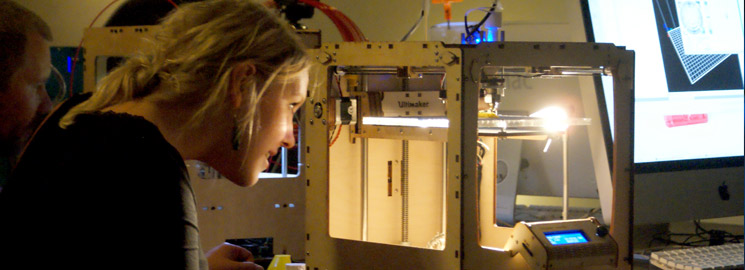Fabrication labs or “Fab Labs” seem to be popping up all around the world these days. Whether you are a student, teacher, or someone with a great design idea these small-scale workshops aim to make “almost anything”. From flash drives to phones fabrication labs are changing the way people create and design the world around them.
The fab lab concept first emerged at MIT many years ago and it initially included a laser cutter, a miniature milling machine and jigsaw cutting machine: it was also around the time people started thinking about creating cheap 3D printers. And so, for anyone looking to design a product they would need to create a prototype of it using these types of tools. They are essentially a way for someone to mock up and create anything they want. Take all of the mobile phones in the world, before they were massed produced they needed to be fabricated first as a prototype. Apple and Samsung for instance all use these labs to test out their latest and greatest ideas for future phones. Take the iPhone 7 just released, it was probably prototyped in Apple’s secret fab lab years before it saw the light of day. Speaking of Apple and prototypes, there is much talk about them secretly working on a driverless Apple car and a fab lab would be the first place they would start.
The cost of the equipment and production has dropped making it accessible for many schools, universities and businesses. These days a 3D-Printer jig saw and a miniature milling machine is all you need to get started. Also, by eliminating many of the barriers of resource and skill that currently prevent ordinary inventors from realizing their own ideas, fab labs can provide an even ground for innovation opening up the market of design and creation to anyone. I like to compare it to the YouTube revolution where anyone now with a recording device and an Internet connection can captivate and connect with millions of people; something that could only be done if you were a multi-billion dollar TV company.
Much like how the mobile computers transformed how we communicate, the ability to directly fabricate functional custom objects could transform the way we design, make, deliver and consumer products. Take the medical industry for instance. Body organs can now be manufactured using a medical 3-d printer. The design and prototyping of all heart valves are now designed and tested in medical fab labs before they make it to the operating room.
Memorial University has one and they are currently offering free sessions to the public this month and next month. Titled “Making At MUN” anyone from the general public can come and experience making something for themselves in the Faculty of Education’s fabrication lab. Anything from wooden toys to 3-D printed objects each session will give any interested individual 10-12 hours of training, access to materials and resources, and the support of onsite experts to design and make something of their own.
And so, anyone who would be interested can contact David Gill at dgill@mun.ca or Gerald Galway at ggalway@mun.ca or they can visit and sign-up at their website at: ritz.citl.mun.ca.


Leave a Reply